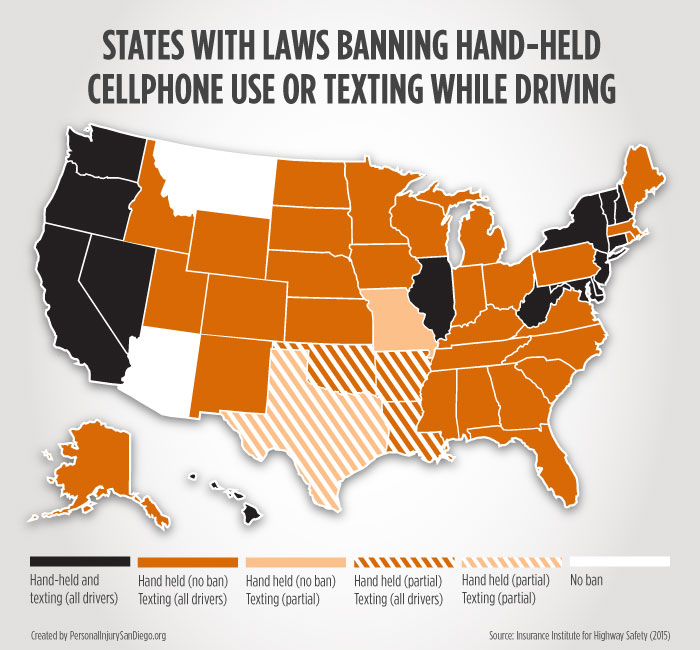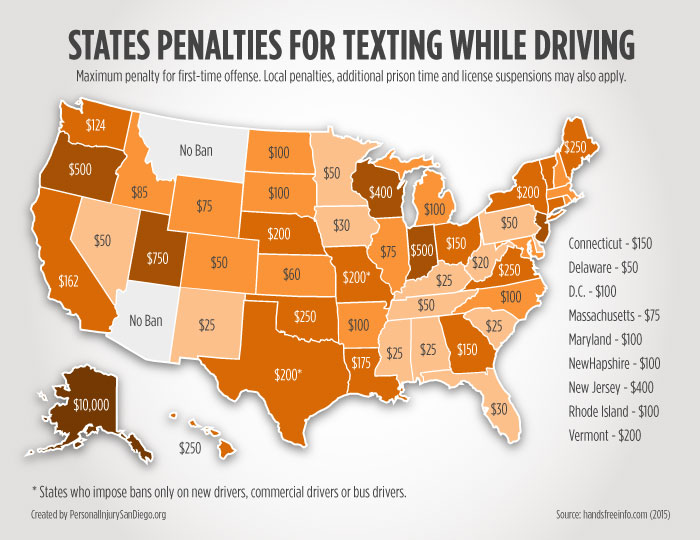Every year in the U.S., almost a half million people are injured or killed in traffic accidents attributed to the combination of texting and driving. The statistics are shocking, especially in view of the fact that this danger could be completely avoided. With the latest statistics available as of 2018, in 2015, according to statistics compiled by the Department of Transportation, 3,477 people died and another 391,000 were injured in motor vehicle crashes caused by drivers who were distracted because they were texting or using cell phones.
Anything that takes your attention away from driving can be a distraction. Sending a text message, talking on a cell phone, using a navigation system, and eating while driving are a few examples of distracted driving. Any of these distractions can endanger the driver and others.
YouTube Special Feature
The Basic Problem – Texting & Driving
The United States has the unwanted lead in this problem, far exceeding similar accidents in other countries around the world. An astounding 69% of drivers (aged 18-64) in the U.S. admitted to using their cell phone while driving during the previous month. Compare this to a European low of 29% in the United Kingdom or 59% in Portugal. Our country takes the lead in other potential distractions also, including reading or sending text messages or email messages, at 31% U.S. vs. 15% in Spain.
Text messaging has become an integral part of life for most people in the U.S. In 2013, over 153 billion text messages were transmitted in this country, including Puerto Rico, the Territories and Guam. Young drivers, under age 20, not only are avid text message users, they make up 27 percent of the drivers in fatal crashes that were attributed to distracted driving. During daylight hours, about 660,000 drivers are using their cell phones or manipulating other electronic devices every moment. This activity increases the risks of becoming involved in an accident by three times over normal risk probability.
Why Texting is So Risky

Texting can make vehicle accidents 23 times more likely to happen.
Distractions from texting outweigh distractibility from other activities, such as talking with a passenger, adjusting the sound system or talking on a cell phone.
Texting, by its very nature, involves at least three separate physical/mental actions, all of which take attention away from the road ahead and potential driving hazards.
- Visual – instead of watching the road ahead, your eyes are looking for a message, lights or other signals inside the car.
- Manual – to operate various controls, your hand or hands must be taken off the wheel while the vehicle is in motion.
- Cognitive –your mind is no longer on your driving but on manipulation of these other devices and understanding the messages and communicating to others.
To make matters worse, the urge to text is almost addictive; people tend to read and answer text messages and cell phone calls immediately. They leave their cell phones turned on so they do not miss any messages or calls. The problem here is that within the few seconds of time used to perform this activity, an accident can occur. The average time taken away from watching the road ahead is just five seconds, but in that time period, a vehicle traveling at 55 mph will go the length of a football field. With attention distracted, it is like driving blindfolded for those few seconds. The results can and often are fatal.
Texting Alternatives Are Not Much Better
 Acknowledging that texting while driving is a danger, some people seek alternative methods of communication. Again, the problem is the basic issue of taking attention away from the road ahead. Use of a headset cell phone is not that much safer than hand-held usage.
Acknowledging that texting while driving is a danger, some people seek alternative methods of communication. Again, the problem is the basic issue of taking attention away from the road ahead. Use of a headset cell phone is not that much safer than hand-held usage.
There are several apps that can be used to avoid the temptations presented when the driver receives text messages.
- Voice Recognition – translates spoken words into text, but you still have to use your hands to send those messages to contacts.
- Auto Responder – these send out a pre-written message to caller when you get instant messages or email messages. This message can explain why you are not answering at the moment – because you are driving.
- Text Blockers – an excellent way for parents to prevent teens from texting while driving. It disables texting when the vehicle is going over 10 mph.
In addition to these apps, the driver can just pull over to text message or turn off their phone while they are in transit.
Despite the best of intentions, even these texting alternatives are not much better. In the long run, the immense attractiveness texting has for most drivers wins over safety. At least a quarter of all teen drivers admit to responding to text messages every time they drive. Most of those teens and about 10 percent of parents also admit that they have lengthy text conversations while they are driving, including multiple messages to their contacts. This extends the brief initial five second lapse of attention much longer, thus greatly increasing chances of an accident.
Who Is Texting While Driving?

The total number of people who are texting while driving is approaching fifty percent. This happens even though drivers have been educated about the dangers of distracted driving. Almost half of young people in high school who are 16 or older admit that they have either driven while texting or have been a passenger in cars where the driver was texting. This young group also is more likely to drink while driving or ride with other drivers who have been drinking, which is another factor that boosts the accident rate for this age group.
Teen drivers have grown up using cell phones and other communication devices. They expect an answer to text messages within five minutes or less. Even though 97% of them agree that texting or email messaging while driving is dangerous, but 43% of them still do it. Surfing the web is another activity engaged in by about 19% of drivers of all ages. Almost one third of older drivers, aged 18-64, admit to being active text and email message senders also. Being warned about the dangers of texting while driving is widespread but ineffective, as teen drivers say that their parents are seen texting while driving.
Gender is another factor to consider when looking at statistics of vehicle crashes attributed to texting while driving. According to a National Occupant Protection Use Survey, women reach for their cell phones while driving more frequently than men. Other activities that women are more likely to engage in while driving include grooming, putting on make-up and using other electronic devices like GPS or sound systems.
Where Drivers are Texting
 There is no geographic limitation to where drivers are texting. Texting and cell phone activity occurs from the moments prior to getting into the driver’s seat until after exiting the vehicle. The urge to communicate is so strong, most people are unable to just turn off the device and ignore it. Many people carry a cell phone for emergency use, but most also can use their cell phones for advanced communications like texting and GPS functions.
There is no geographic limitation to where drivers are texting. Texting and cell phone activity occurs from the moments prior to getting into the driver’s seat until after exiting the vehicle. The urge to communicate is so strong, most people are unable to just turn off the device and ignore it. Many people carry a cell phone for emergency use, but most also can use their cell phones for advanced communications like texting and GPS functions.
Modern smartphones have apps for all types of activities, including locating restaurants, gas stations and other businesses that a driver may be interested in finding.
These positive functions only increase the chances of a driver texting or manipulation an electronic device. Many newer vehicles have large computer screens on the dashboard that offer GPS and cell phone interconnection. Others have smaller screens directly in front of the steering wheel, and controls on the steering wheel. The problem remains the same, no matter how modern or convenient a device may be: text or email messaging or using electronic data devices while driving takes the driver’s attention away from the road ahead.
When Do Drivers Text?
 There is no limit to when a driver may text.
There is no limit to when a driver may text.
As soon as their cell phone rings or they receive an incoming text message or email, they want to respond. Most do not bother to pull over or off the road to do this. Most drivers also have a belief that they are capable of multi-tasking, so texting while driving is not a problem in their minds. However, the facts dispute this belief, as every day over 9 people are killed and over 1,153 people are injured every day in the United States as a result of distracted driving.
The sad fact is that these crashes could have been avoided if the driver had not been distracted at that critical moment.
Solutions for Texting While Driving
The only real solution to stop distracted driving accidents is to eliminate the distraction. While this is possible in some cases, there are many distractions that laws cannot address, like talking with other passengers, or eating and drinking while driving. Education and training can only go so far to prevent distracted driving when almost half of all drivers ignore those facts and warnings about the dangers of texting while driving. Resorting to the legal system is one solution for this problem.
Nationwide, 43 states have passed laws to prohibit drivers from texting. The Federal Government also took several important steps to address potential distracted driving problems:
Source: PersonalinjurySanDiego.org (This graphic is free to use as long as proper citation is given)
- The commercial trucking industry also has new stringent rules for drivers with regard to texting and cell phone usage enacted in 2010 by the Federal Motor Carrier Safety Administration.
- That same year, the Federal Railroad Administration passed bans to keep railroad employees from using cell phones or electronic devices while on the job.
- In conjunction with the FMCSA rules, the Pipeline and Hazardous Materials Safety Administration issued bans in 2011 against hand-held cell phone use specifically directed to hazardous materials carriers.
- In 2009, the Federal Government also passed legislation prohibiting their employees who are driving government equipment or driving on government business from texting while driving.
Industry Responses
 Due to the obvious dangers inherent in texting or email messaging while driving, several industry responses have been initiated in recent years. Hand-free cell phones, the Bluetooth models, and other devices have been re-engineered for safer use by drivers. Voice activated apps are now available that allow messaging without needing to hold the phone or manually text the message. A few new cars even feature self-driving capability; this is very scary to some people when control is the goal!
Due to the obvious dangers inherent in texting or email messaging while driving, several industry responses have been initiated in recent years. Hand-free cell phones, the Bluetooth models, and other devices have been re-engineered for safer use by drivers. Voice activated apps are now available that allow messaging without needing to hold the phone or manually text the message. A few new cars even feature self-driving capability; this is very scary to some people when control is the goal!
Some new vehicles have computerized screens that can interface with cell phones, again to allow use without actually needing to touch the device. Drivers can keep their hands on the wheel and eyes ahead at the road they should be watching. There still is the issue of using one’s mind to perform these duties. Anything that detracts from giving driving your full attention is a potential hazard that could result in an accident.
State Responses
In 43 states and D.C., it is illegal to text while driving. Statistics compiled in recent years show that every day in the U.S., 9 people die and over 1,153 are injured in distracted driver crashes. In 2011, this breaks down to 17%, or almost one in five crashes that were due to distracted driving. Despite these laws and vigilant patrolling by police, it continues to be typical to see many drivers talking on cell phones or looking down to do texting.
The state of California for example has primary and secondary laws about texting and cell phone use while driving. Special laws apply to drivers under age 18; novice drivers. They are banned from using any cell phone, handheld or hands-free. Bus drivers have the same restriction. Drivers of all ages are banned from using handheld devices. Texting while driving is illegal for all drivers.
State Penalities
Here are additional statistics on ho how states around the country have responded to maximum penalities for first time offenders.
Source: PersonalinjurySanDiego.org (This graphic is free to use as long as proper citation is given)
Information is a Key Solution
 Governments, safety organizations, parents and schools all offer information that proves how dangerous a combination texting and driving is.
Governments, safety organizations, parents and schools all offer information that proves how dangerous a combination texting and driving is.
Getting drivers of all ages to not only absorb this information, but to react in a responsible manner to this hazard is extremely difficult. The modern age of instant communications is an attractive nuisance as it applies to texting and driving. A majority of young drivers, those most at risk for causing accidents due to texting while driving, admit they have been told about this danger. Still, they persist in taking this risk. They may only curtail this activity after someone they personally knew died due to an accident caused by a texting driver.
In addition to information, a continuing publicity effort by everyone nationwide is helping to spread this information to drivers of all ages. This issue is fairly new, but as the use of cell phones and other electronic communication devices spreads, it must be addressed at all levels of influence.
Personal Injury Legal Assistance
If an accident or deliberate harmful behavior caused by texting or distracted driving injured you, or death to a loved one, it is time to take action and fight back.
Common Areas of Practice
- Car Auto Accident Lawyer
- Wrongful Death Lawyer
- Slip and Fall Lawyer
- Brain Injury Lawyer
- Dog Bite Lawyer
- Bicycle Accident Lawyer
- Work Injury Lawyer
- Motorcycle Accident Lawyer
- Truck Accident Lawyer
- Pedestrian Accident Lawyer
- Defective Product Lawyer
- Ride Sharing Accident Lawyer
- Medical Malpractice Lawyer
- Nursing Home Abuse Lawyer
- Elevator/Escalator Accident Lawyer
- Hotel Injury Lawyer
- Commercial Property Lawyer
- Work Injury Lawyer
- Wrongful Death Medical Malpractice











